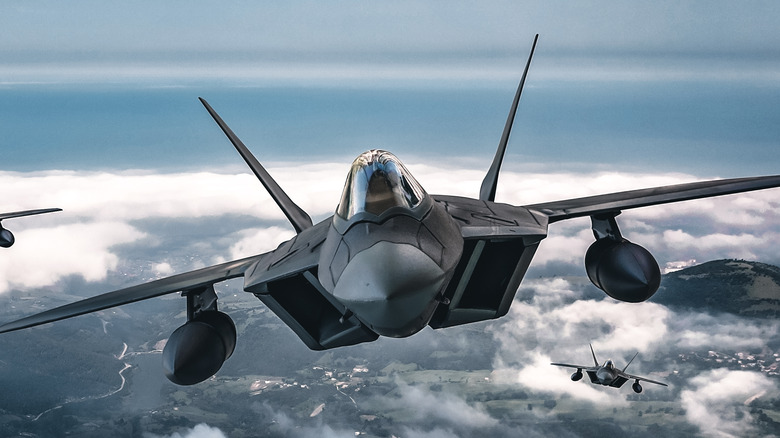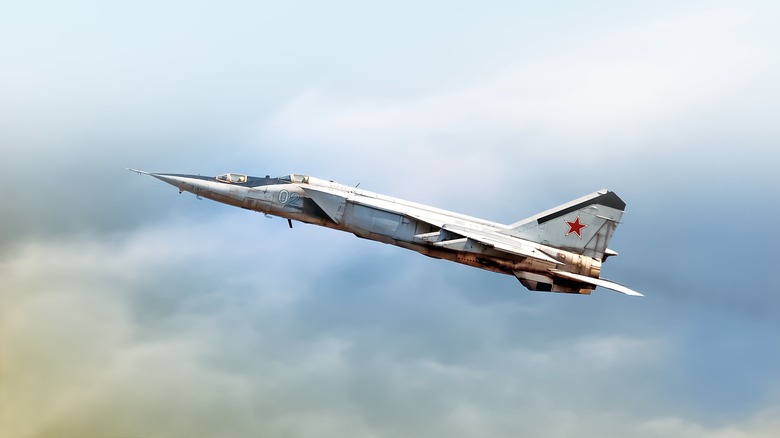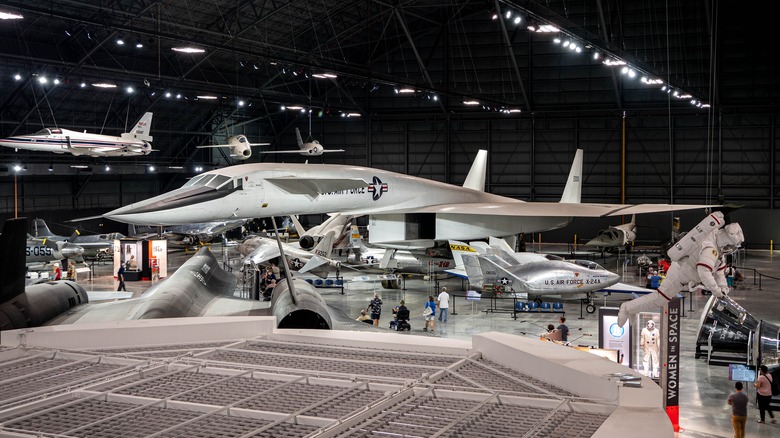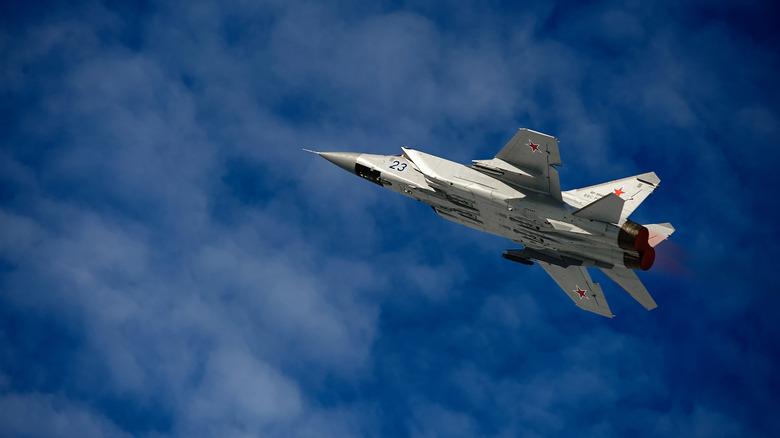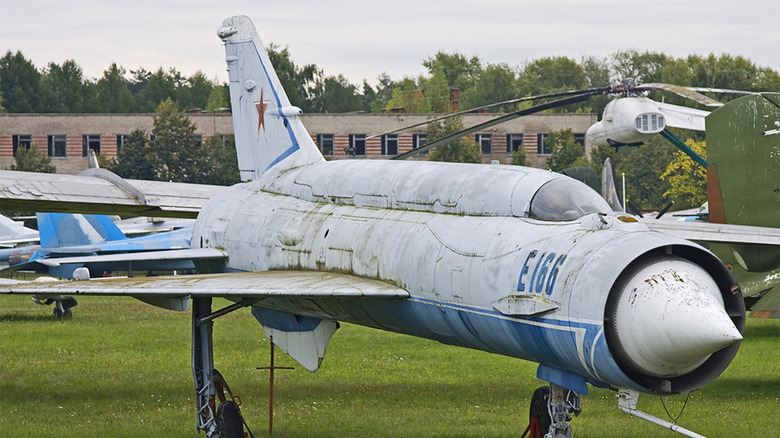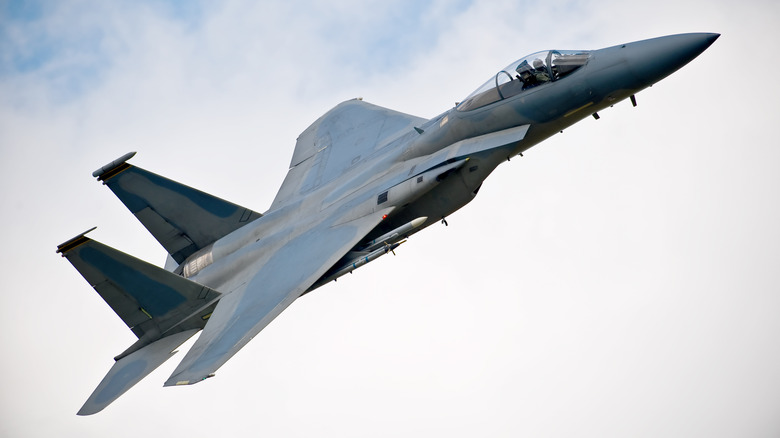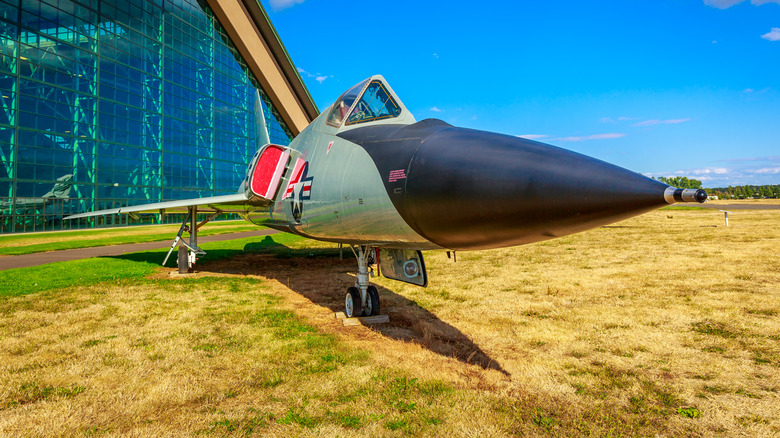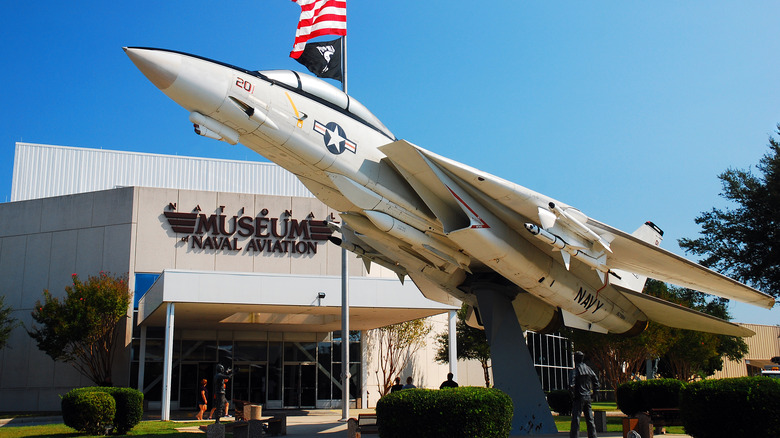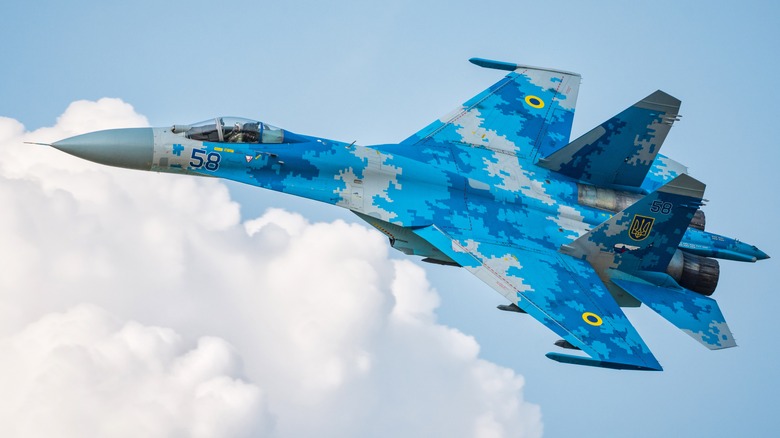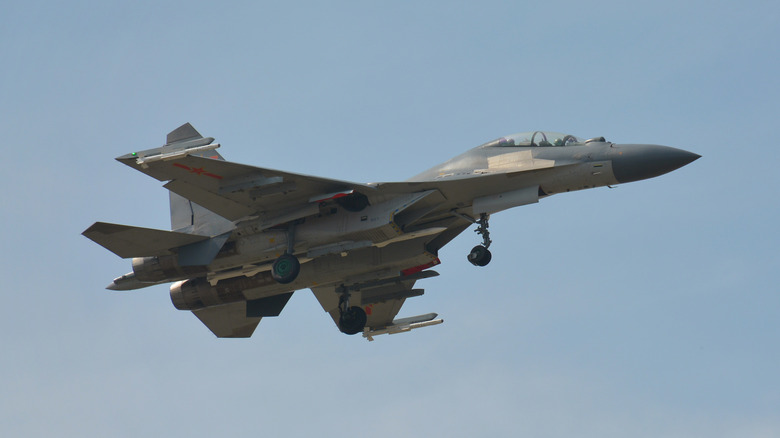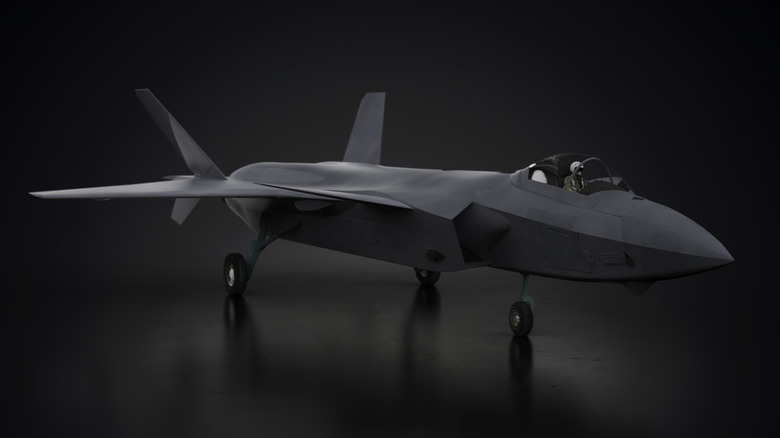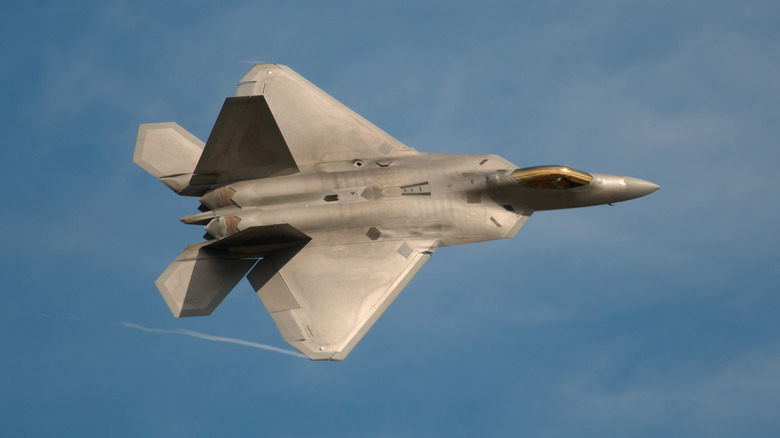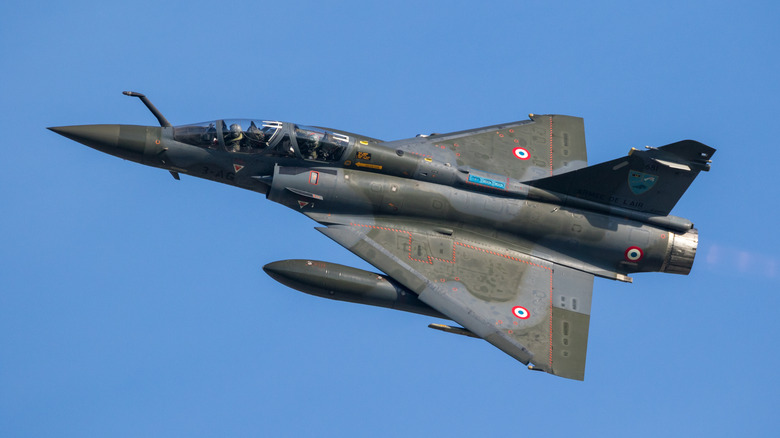12 Of The Fastest Fighter Jets In The World, Ranked
Fighter jets are some of the most popular types of aircraft with enthusiasts. They look cool, they go fast, and their dogfighting is super entertaining to watch. Fighter jets are also featured in video games such as the "Ace Combat" series, and several fighter jets were featured in "Top Gun". Not only are they quick, but they're also agile, pulling off all kinds of crazy moves midair. In addition, fighter jets are also some of the most expensive vehicles in any given military, often costing billions of dollars to design, develop, and ship.
Agility, technology, and weapon systems are often used to measure the strength of a fighter jet. However, speed is also crucial. There are a variety of fast aircraft out there, including the SR-71, which can eclipse Mach 3 speeds at incredibly high altitudes. Prototype planes such as the Lockheed YF-12 have reportedly gone as fast as Mach 3. However, not a lot of data exists on prototype aircraft. Modern fighter jets can't go that fast, but many can do Mach 2 without issue.
Unfortunately, jet speeds are not always exacting rates you can figure out. Not only can planes fly faster at higher altitudes, but Mach values change depending on how far up you are above sea level. Mach 1 is roughly 760 mph at sea level and drops to 659 mph at 60,000 feet. The less dense air at higher altitudes allows planes to move faster while colder air causes sound to move slower. Thus, it's not unusual for most aircraft to have multiple reported speeds.
Mikoyan-Gurevich MiG-25 Foxbat
The Mikoyan-Gurevich MiG-25 Foxbat travels at a top speed of Mach 2.8, or roughly 2,150 mph at high altitude. That makes it the second fastest jet on Earth behind only the SR-71. The fighter jet has been deployed by multiple militaries since its first flight in 1964. MiGs are primarily used in Russia. These days, only two remain in service and both of them belong to the Syrian Air Force. In addition to fighting, the MiG-25 was also commonly used for recon work. Iraq used the fighter jet often during the Gulf War, specifically for reconnaissance.
It was designed primarily to fly as fast and as high as possible. Its speed is truly impressive, but don't overlook its 67,000-foot maximum altitude. That's what really gives it an advantage over other fighters. The downside is that the jet was quite difficult to maneuver, and it required tons of maintenance to remain effective. In fact, it required a engine replacement every 150 flight hours. It was eventually phased out for the MiG-31, which was slower overall, but featured more advanced technology and better maneuverability.
The MiG-25 Foxbat set several speed and altitude records in its early days. It also had a huge effect on aerospace technology moving forward. The U.S. created the F-15 to counter the MiG-25, but ultimately, the MiG-25's high maintenance costs and focus on speed over agility caused it to age poorly.
North American XB-70 Valkyrie
The North American XB-70 Valkyrie is a unique bomber-style of fighter jet. Most stat sheets put this jet as having a top speed of around 2,050 mph, which, depending on the altitude, is about Mach 3. It wasn't able to cruise at those speeds and spent most of its time in the sky at a slower, but still impressive Mach 2.5. It was experimental its entire lifetime, but there is enough speed data to know how fast it could go. The plane achieved these speeds by way of six jet engines and being made of lighter, more heat-resistant materials.
In addition to its high speed, the aircraft could also go as high as 70,000 feet, which is much higher than most fighter jets. It was developed in the 1950s and 1960s, and it was meant as a replacement to the iconic B-52 bomber. It never officially went into production, but the U.S. Air Force got its hands on two of them to test the aerodynamics of large supersonic aircraft.
This is where things get really interesting. The bomber's design was eventually switched to recon work where it was rebranded as the RS-70. A few more design tweaks and a former President Lyndon B. Johnson naming flub later, and the RS-70 would finally go into production as the legendary SR-71. Of course, the SR-71 can go faster than the XB-70, but it also isn't a fighter jet.
Mikoyan MiG-31
The Mikoyan MiG-31 Foxhound is the fighter jet that officially replaced the MiG-25 Foxbat. It has a top speed of roughly 1,900 mph. It can do faster bursts for short periods of time, but it risks permanent damage when doing so. The replacement had some notable improvements over the outgoing MiG-25. It was easier to fly at lower altitudes, had improved agility, could fly longer ranges, and its engines didn't need replaced as frequently. The MiG-31 was also made of stronger, lighter materials along with better overall technology. The only downside was that it couldn't go as fast as its predecessor.
The MiG-31 is still used today in several countries. Russia sent it out to Finland, Syria, Kazakhstan, and other places. There are also multiple variants, such as the MiG-31F, MiG-31B, and MiG-31M. These hosted different types of technology, improvements from the original, and other weapons to perform multiple types of missions. There is even an experimental version, dubbed the MiG-31LL, that Russia uses for aircraft testing.
Unlike its predecessor, this one is still widely used. Russia intends to fly them until at least 2030. These days, the Russian Air Force predominately uses the MiG-31BM variant, which is the most recent production model with several improvements over the original. The Russians are in the process of modernizing their fighter jets so that they can deploy as long as possible.
Mikoyan-Gurevich Ye-152
The Mikoyan-Gurevich Ye-152 is part of the Mikoyan-Gurevich Ye-150 family of fighter jets initially designed for the Soviet Air Defense Forces. Among the family, which includes over half a dozen major variants and even more subvariants, the Ye-152 is the fastest one with a top speed of roughly 1,880 mph at an altitude of 50,525 feet. That's fast enough to put in the upper echelon of quick fighter jets. The jet was powered by a Tumansky R-15B-300 turbojet engine. That is of note because it was the same engine as the MiG-25 Foxbat, except the MiG-25 had two of them. The Ye-152 only had one.
The Ye-152-1 in particular set multiple FAI-recognized speed and altitude world records. That puts it leagues above most other fighter jets. Unfortunately, due to a variety of factors, the Ye-150 series of fighter jets never reached production. Reports state that electronic issues, engine reliability problems, and developmental delays ultimately led to the project being abandoned in the early 1960s. Those same engine reliability problems plagued the MiG-25 Foxbat as well.
Only four Ye-150 family models were ever produced. Today, only the Ye-152M remains. It lives in the Central Air Force Museum in Monino, Russia. Its legacy carries on in other ways. The R-15 series of turbojet engines would eventually get some much needed upgrades. A variant of the engine was put into a Ye-266M, which is an experimental variant of the MiG-25. That lone jet currently holds the world altitude record for ground-launched aircraft at 123,523 ft.
McDonnell Douglas F-15 Eagle
The McDonnell Douglas F-15 Eagle is one of the best fighter jets in the U.S. Air Force arsenal. It blends an excellent mix of maneuverability and speed, and some variants can reach speeds of up to 1,875 mph. In general, the base models aren't as fast, but can still do about 1,650 mph. The jet was produced in the 1970s in response to Russia's MiG-25 and MiG-31. Variants were produced throughout the jet's run, including some newer ones for the Persian Gulf War in the early 1990s. The fighter jet is still in service today in a few countries, including the U.S., Japan, and Israel.
The jet has a number of variants, including the F-15E Strike Eagle. Most of them are capable of the same 1,650 mph that the standard version has. In addition, the F-15 has some cool technology. The aforementioned F-15E, for example, can accelerate from idle to maximum power in just four seconds. It also houses a heads-up display that displays a video picture at night that makes everything look like it does during the day. The F-15 series in general was the first U.S. aircraft to have thrust that exceeded the jet's weight, allowing it to accelerate while 100% vertical.
It doesn't have the pop culture relevance of other fighter jets like the F/A-18 Super Hornet from "Independence Day" or the F-14 Tomcats from "Top Gun: Maverick", but it's every bit as awesome as its movie star brethren. Some variants of the F-15 are heading toward retirement, but they are expected to remain in use by the U.S. Air Force for at least a while longer.
Convair F-106 Delta Dart
The Convair F-106 Delta Dart is the beginning of a series of fighter jets that have very similar speeds. This one has a top speed of roughly 1,587 mph. It uses the same engine as the F-105 Thunderchief, and the two can go roughly the same speed depending on the altitude. The F-105 was a bomber whereas the F-106 was an interceptor. The aircraft went into production in 1956 and became fully operational for the U.S. Air Force in 1959, just in time for the Vietnam War. It would eventually retire from service in the late 1980s after more powerful fighter jets took its place.
Convair's F-106, a single engine jet fighter, was quite quick for its day. The F-106A variant of the aircraft broke world speed records back in 1959. It was beaten in 1971 by the McDonnell Douglas F-4 Phantom, which housed a dual-engine design. The single engine record would stand for one more year before it was beat by the Ye-152. Enthusiasts dispute that the Ye-152 eclipsed the record, but even if it did, the F-106 was still one quick fighter jet.
There are still some F-106s around today. Most of them are in museums. There is at least one fun story about the F-106. In 1970, a pilot was flying one in Montana. The pilot lost control and ejected from the jet. For some reason, this caused the jet to cease its spinning and the unpiloted F-106 landed itself in a snow-covered field. After minor repairs, that F-106 re-entered service where it would spend another 16 years before retiring to a museum.
Grumman F-14 Tomcat
The Grumman F-14 Tomcat is another iconic jet used by the United States armed forces — this time with the U.S. Navy. Its top speed is roughly 1,554 mph. It's perhaps best known as one of the fighter jets used in the original "Top Gun" movie. The jet was excellent even outside of cinema. It could guide six missiles against six different targets while keeping track of 18 additional enemy aircraft up to 195 miles away. In fact, it was such a technological marvel in the 1970s that Russia tried to fish one out of the ocean to figure out how it worked.
The dual-engine jet is certified as a Mach 2 class fighter and joins several others in the 1,500-mph club. While its speed didn't set it apart from others all that much, the fact that it could do so many things did. It was developed as the successor to the popular F-4 Phantom II. Some of its features included variable wings that adjusted based on speed and altitude along with a rotary cannon for up close dogfighting.
Grumman's F-14 got even more advanced over the years. For example, it was fitted with laser-guided bombs during NATO's 1995 intervention in Bosnia. The jet was eventually retired in the early 2000s with the U.S. destroying most of its stock to keep its design secret. The remaining stock are predominately in museums these days. It was replaced by the F/A-18 Super Hornet, which saw its own cinema action in "Top Gun: Maverick".
Sukhoi Su-27
The Sukhoi Su-27 is a legendary fighter jet often compared to the F-15 Eagle. The Su-27 has a top speed of about 1,550 mph, which translates to Mach 2.35 at altitude. The reason for the comparison is that the Soviet Union specifically designed this fighter jet in response to the F-15. It's not quite as quick but matches the F-15 in other areas. It can fly as high as 59,000 ft and it can fly for more than 1,800 miles before needing to refuel. Those are impressive numbers.
The Su-27 officially entered service in 1982 and were immediately implemented in Russia, Ukraine, Belarus, Kazakhstan, Indonesia, and a few others. India joined the Su-27 party in 2002. China also ordered some in 2004 while Mexico added some in 2006. The Su-27 has seen combat as recently as 2023 after Russian forces invaded the Ukraine in 2022.
Powering the Su-27 are two AL-31F turbofan engines. Modern versions have some tweaked engines for performance boosts as well. It's only natural that a jet fighter in production as long as the Su-27 gets some mechanical modifications over the course of its life. It's likely that these will remain in service for decades if it adheres to the notion that military aircraft tend to last about 50 years. However, the Su-35 and Su-57, the successors to the Su-27 with similar top speeds, are already out, so the Su-27's days may be numbered.
Shenyang J-15
The Shenyang J-15 Flying Shark is an interesting piece of military technology. The base speed of the J-15 is Mach 2.4, or about 1,550 mph depending on altitude. It's one of the newest fighter jets on the list as it was introduced to the world in 2013. It's used exclusively by the People's Liberation Army Naval Air Force in China. As such, it's a little difficult to nail down the full spec sheet of this fighter jet. It's a cousin of the Shenyang J-11 that was released in 1998. However, the J-15 is not technically based on the J-11 despite their similar names.
Instead, the J-11 and J-15 are China's versions of the Sukhoi Su-27 and Su-33, respectively. Thus, it makes sense that these fighter jets are about as fast and well equipped as their Sukhoi counterparts. Early models even used the same AL-31 powerplant as their Su counterparts before switching to the Chinese-made WS-10 in 2022. There are some differences outside of the engine, but at a distance, you'd be forgiven for mistaking one for the other.
The only question mark is how fast the WS-10 engines are. The Chinese have reported the rated speed was Mach 2.4 back in 2017. That's before the WS-10 engines came into service, so there isn't a lot of documentation about how fast the newer engine is with the J-15. Given the dates, the rated speed is most likely with the older AL-31 engine, so newer J-15s may be even faster. There are roughly 50 in operation right now and the jet is still in production today.
Chengdu J-20
The Chengdu J-20 is the newest jet fighter on this list courtesy of China. It has a rated speed of Mach 2, which is roughly 1,320 mph depending on altitude. However, Popular Mechanics lists the J-20 as achieving a top speed of Mach 2.55, which is roughly 1,650 mph at altitude. That makes the J-20 the fastest fighter jet that China has right now, but it also doesn't seem like it can sustain flight at that speed for very long. The jet was built with the Chinese-made WS-10 engine, but later variants are getting the newly made WS-15 engines in 2023. The new engines would make its top speed similar to the F-22 Raptor's 1,550 mph. That means there are three potential rated speeds for this jet.
For most fighter jets, almost the complete history is available, including variants, experimental versions, and prototypes. The Chengdu J-20 is right at the beginning of what will likely be a decades-long trek through the Chinese military industrial complex, so there are a lot of things that can still happen with it. There are already a few variants, including the J-20B which is the variant equipped with the new engines. There will be more, so it may end up being even faster by the time it retires.
For now, the Chengdu J-20 is in production and service right now. China seems to have north of 200 of them in service right now, and they make up a decent percentage of China's jet fighters.
Lockheed Martin F-22 Raptor
The Lockheed Martin F-22 Raptor was pressed into service in 2005 when it went into full production. It's rated top speed is somewhere around 1,550 mph, which is more or less the norm for Mach 2-class fighter jets. In addition to its excellent speed, the F-22 Raptor also boasts some serious hardware and technology, including the ability to cruise at Mach 1.5 without using afterburners. In addition, it can carry over 2,000 pounds of munitions and detect enemies well over 200 miles away. There isn't much this fighter can't do when compared to its peers.
While the F-22 is still in U.S. Air Force service today, there is a push to retire some of them early. They are expensive to maintain, and some of the older ones in the fleet would require costly preparation to make them combat ready again. Congress has blocked it so far, but it seems the Air Force is trying each year to get the job done. The broken-down F-22s only make up about 20% of the total number in the fleet, so the U.S. will still have F-22s flying around after some of them are retired.
Other than the older models being retired, the F-22 has caused other problems in military circles. They are quite expensive at $125 million per jet, and the Air Force already has a weighty budget. Additionally, the U.S. is already working on the next generation of fighter jets for its arsenal.
Dassault Mirage 2000
The Dassault Mirage 2000 is last on the list, but it is by no means a slow fighter jet. It boasts a maximum speed of Mach 2.2 at high altitude, which translates to roughly 1,450 mph. It began life in 1978 with some variants distributed as recently as 1991. This one is still in use in many countries around the world, including Abu Dhabi, Egypt, France, Greece, India, and Taiwan. The most recent variants came out in the mid-2010s, so this is very much a modern jet fighter.
As such, it has a lot of modern amenities. It can attach up to nine weapons and includes two internally mounted machine guns. There is also digital weapons and navigations systems, something older fighters don't have. The original version was built for the French Air Force, which uses the upgraded models today. It's so popular that there are over 500 of them in operation, which is quite a large number for military aircraft. There are also single- and double-seater versions of the jet along with a variant specifically designed to carry nuclear weapons.
It's hard to say how long the Dassault Mirage 2000 will be in service, but it'll likely be a while. They're still being actively manufactured and air forces on multiple continents use them for a variety of purposes. This one never broke any speed or altitude records like others on this list, but it's still pretty quick overall.
